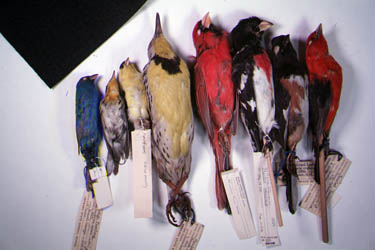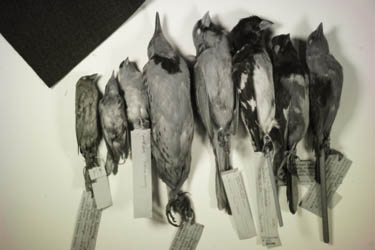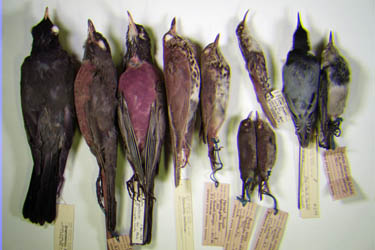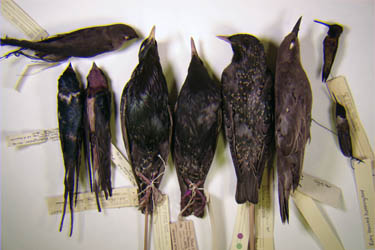Ultraviolet Bird Photography by Nathan Chronister
Study Skins Collection
The specimens in these photos are scientific study skins in the collection of the State University of New York at Geneseo. I would like to acknowledge Dr. George Briggs and Ed Beary for providing access to the collection. Photographing the study skins allowed a broad census of bird species in order to determine which species might have significant ultraviolet coloration. This in turn could be used to guide the selection of species to photograph in the field.
 |
This is the visible light photo for a group of birds in the collection. Indigo bunting, blackburnian warbler, goldfinch, meadowlark, cardinal, rose-breasted grossbeak, rufous-sided towhee, and scarlet tanager. The black card in each image, together with the white background, makes it possible to adjust the brightness so it's the same for all four color channels. This process, called "normalization", allows us to see how much ultraviolet light is reflected from an object, in comparison to the other colors. |
|
 |
The ultraviolet reflectance seems uneventful on first glance. Black feathers still appear black, and white feathers still appear white. Not surprisingly, the indigo bunting reflects a bit of ultraviolet light, almost as much as the white breast of the warbler. What surprised me was the high ultraviolet reflectance from yellow and red feathers, especially on the cardinal. These areas don't reflect blue light, but they reflect a fair amount of ultraviolet. | |
 |
In this picture, I squeezed the four color channels (ultraviolet, blue, green, and red) into a single RGB image. Ultraviolet becomes blue, blue becomes green, yellow becomes orange, and red stays red. Here the cardinal takes on a purple color because it reflects both red and ultraviolet light. |
 |
Ultraviolet coloration of birds may have a role in mate selection. In this case, the male American robin (third from left) takes on a shockingly different hue from the female. This is caused by the greater UV reflectance of the male. The human eye merely perceives the male as a darker shade of rust, but apparently birds will see it as a totally different color. For predators lacking UV vision, the male robin will still retain his camouflage. |
 |
I was eager to photograph the starlings, because some other photographers had reported ultraviolet reflectance on these birds. But this normalized image makes it clear: The starling's irridescent colors extend into the UV part of the spectrum but are not stronger than the visible colors. As with the picture above, ultraviolet shows up as blue here. The barn swallow actually shows more ultraviolet coloration than the starling. |
Dr. Klaus Schmitt has photographed starlings using a different type of UV camera. In his method, a UV filter is used to deliver ultraviolet light onto the red, green, and blue image sensors of a modified digital camera. The RGB color sensors have differing sensitivities to ultraviolet light. That produces different colors that corespond to high and low wavelengths within the ultraviolet portion of the spectrum.
Ultraviolet Photo Galleries